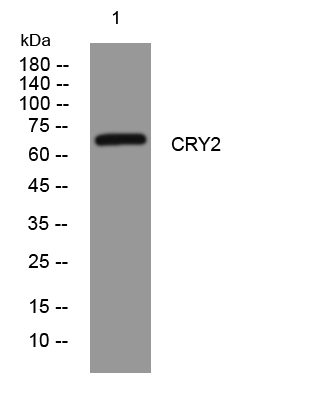CRY2 rabbit pAb
- Catalog No.:YT6482
- Applications:WB
- Reactivity:Human;Mouse;Rat
- Target:
- CRY2
- Fields:
- >>Circadian rhythm
- Gene Name:
- CRY2 KIAA0658
- Protein Name:
- CRY2
- Human Gene Id:
- 1408
- Human Swiss Prot No:
- Q49AN0
- Mouse Gene Id:
- 12953
- Mouse Swiss Prot No:
- Q9R194
- Rat Gene Id:
- 170917
- Rat Swiss Prot No:
- Q923I8
- Immunogen:
- Synthesized peptide derived from human CRY2 AA range: 181-231
- Specificity:
- This antibody detects endogenous levels of CRY2 at Human/Mouse/Rat
- Formulation:
- Liquid in PBS containing 50% glycerol, 0.5% BSA and 0.02% sodium azide.
- Source:
- Polyclonal, Rabbit,IgG
- Dilution:
- WB 1:500-2000
- Purification:
- The antibody was affinity-purified from rabbit antiserum by affinity-chromatography using epitope-specific immunogen.
- Concentration:
- 1 mg/ml
- Storage Stability:
- -15°C to -25°C/1 year(Do not lower than -25°C)
- Molecular Weight(Da):
- 65kD
- Background:
- This gene encodes a flavin adenine dinucleotide-binding protein that is a key component of the circadian core oscillator complex, which regulates the circadian clock. This gene is upregulated by CLOCK/ARNTL heterodimers but then represses this upregulation in a feedback loop using PER/CRY heterodimers to interact with CLOCK/ARNTL. Polymorphisms in this gene have been associated with altered sleep patterns. The encoded protein is widely conserved across plants and animals. Two transcript variants encoding different isoforms have been found for this gene. [provided by RefSeq, Feb 2014],
- Function:
- cofactor:Binds 1 5,10-methenyltetrahydrofolate non-covalently per subunit.,cofactor:Binds 1 FAD per subunit.,function:Blue light-dependent regulator of the circadian feedback loop. Inhibits CLOCK|NPAS2-ARNTL E box-mediated transcription. Acts, in conjunction with CRY2, in maintaining period length and circadian rhythmicity. Has no photolyase activity. Capable of translocating circadian clock core proteins such as PER proteins to the nucleus. May inhibit CLOCK|NPAS2-ARNTL transcriptional activity through stabilizing the unphosphorylated form of ARNTL.,online information:Cryptochrome entry,PTM:Phosphorylation on Ser-266 by MAPK is important for the inhibition of CLOCK-ARNTL-mediated transcriptional activity. Phosphorylation by CSKNE requires interaction with PER1 or PER2.,similarity:Belongs to the DNA photolyase class-1 family.,similarity:Contains 1 DNA photolyase domain.,subcellular locat
- Subcellular Location:
- Cytoplasm . Nucleus . Translocated to the nucleus through interaction with other Clock proteins such as PER2 or ARNTL.
- Expression:
- Expressed in all tissues examined including fetal brain, fibroblasts, heart, brain, placenta, lung, liver, skeletal muscle, kidney, pancreas, spleen, thymus, prostate, testis, ovary, small intestine, colon and leukocytes. Highest levels in heart and skeletal muscle.
- June 19-2018
- WESTERN IMMUNOBLOTTING PROTOCOL
- June 19-2018
- IMMUNOHISTOCHEMISTRY-PARAFFIN PROTOCOL
- June 19-2018
- IMMUNOFLUORESCENCE PROTOCOL
- September 08-2020
- FLOW-CYTOMEYRT-PROTOCOL
- May 20-2022
- Cell-Based ELISA│解您多样本WB检测之困扰
- July 13-2018
- CELL-BASED-ELISA-PROTOCOL-FOR-ACETYL-PROTEIN
- July 13-2018
- CELL-BASED-ELISA-PROTOCOL-FOR-PHOSPHO-PROTEIN
- July 13-2018
- Antibody-FAQs
- Products Images

- Western blot analysis of lysates from U2OS cells, primary antibody was diluted at 1:1000, 4°over night



